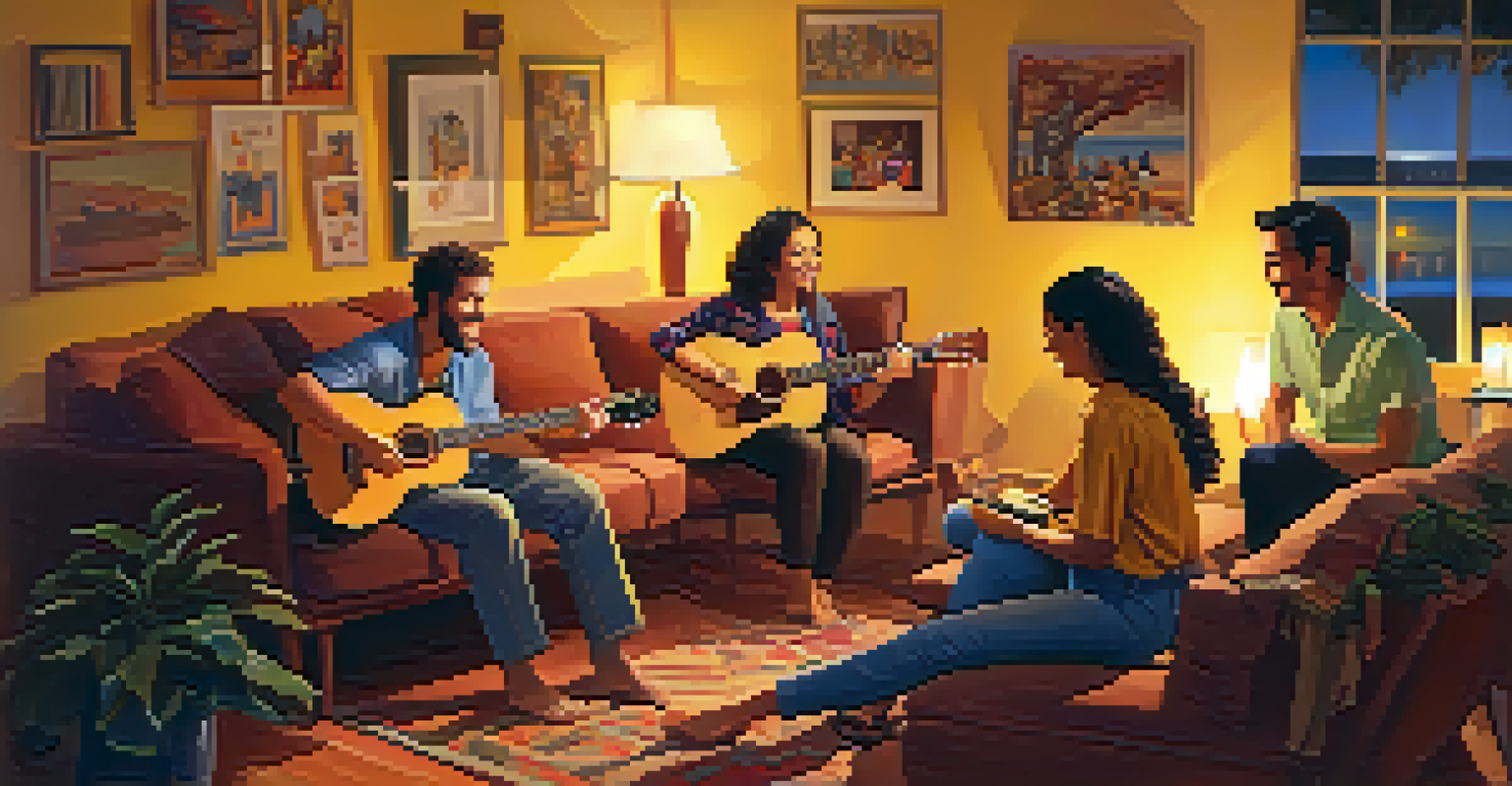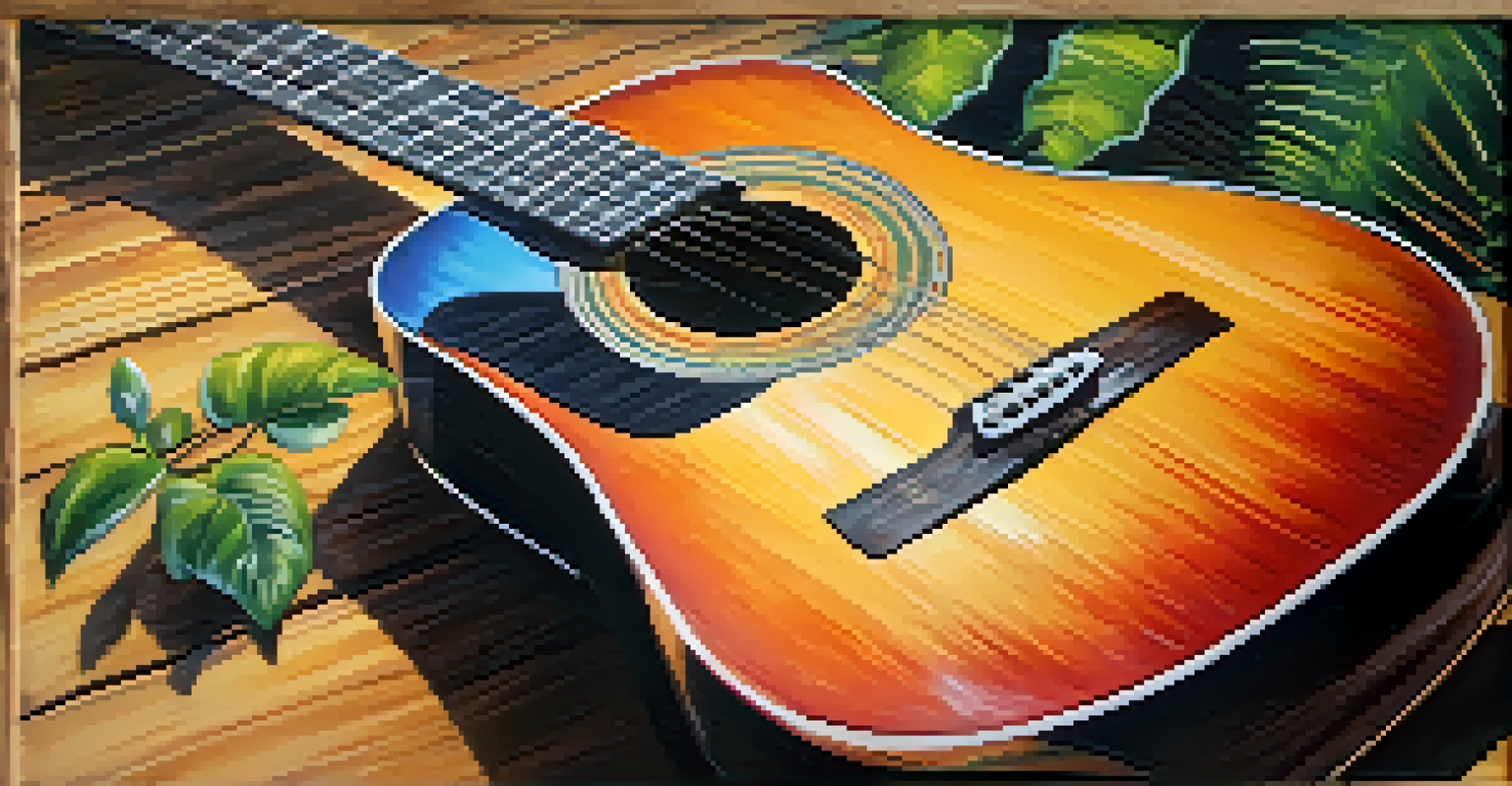The Rhythms of Bossa Nova: Brazilian Guitar Styles Explained

What is Bossa Nova? A Brief Introduction
Bossa Nova is a captivating musical genre that originated in Brazil in the late 1950s. Blending samba rhythms with jazz influences, it brings a unique sound that's both soothing and complex. The term 'Bossa Nova' translates to 'new trend,' reflecting its innovative approach to traditional Brazilian music. This genre has since captured hearts worldwide, becoming synonymous with Brazilian culture.
Bossa Nova is a feeling, a rhythm, a sound that dances in the heart of Brazil.
Characterized by its smooth melodies and intricate guitar work, Bossa Nova is often recognized for its relaxed tempo and airy feel. Artists like João Gilberto and Antonio Carlos Jobim were pioneers, infusing their compositions with rich harmonies and syncopated rhythms. Their music invites listeners to immerse themselves in the laid-back vibe that's emblematic of Brazilian beaches and sunsets.
As you dive deeper into Bossa Nova, you’ll discover how its essence is woven into the fabric of Brazilian life. Whether it’s played in intimate gatherings or grand concerts, this genre evokes a sense of nostalgia and warmth. Understanding Bossa Nova is not just about the notes; it's about feeling the rhythm of Brazil itself.
The Instrument: The Brazilian Guitar
At the heart of Bossa Nova lies the Brazilian guitar, a key instrument that shapes its sound. Unlike the standard acoustic guitar, Brazilian guitarists often use nylon strings, which produce a softer, warmer tone. This choice contributes to the genre's signature sound, allowing for intricate fingerpicking techniques that create a rich tapestry of sound.

The guitar in Bossa Nova is not just a background instrument; it takes center stage, often leading melodies while simultaneously providing rhythmic support. Players frequently employ a technique called 'batida,' which involves striking strings with the thumb while simultaneously plucking with the fingers. This creates a unique syncopation that enhances the overall groove of the music.
Bossa Nova's Unique Sound
Bossa Nova blends samba rhythms with jazz influences, creating a soothing yet complex musical genre that reflects Brazilian culture.
Moreover, the guitarists' ability to blend harmony and rhythm showcases the technical prowess required in Bossa Nova. Through chord voicings and embellishments, they add color and depth to their playing. Understanding the guitar's role in Bossa Nova is essential to appreciating how it drives the genre's enchanting rhythms.
Key Characteristics of Bossa Nova Guitar Styles
Bossa Nova guitar styles are marked by several distinctive characteristics that set them apart from other genres. One of the most notable features is the use of syncopated rhythms, which creates a laid-back yet engaging feel. This rhythmic complexity is often what draws listeners in, inviting them to sway along with the music.
Music is the universal language of mankind, and Bossa Nova speaks it fluently.
Another defining aspect is the harmony used in Bossa Nova songs. Guitarists frequently utilize extended chords and sophisticated progressions that bring a jazz influence into play. This harmonic richness adds an emotional layer to the music, allowing for deeper interpretation and expression.
Finally, the contrasting dynamics in Bossa Nova guitar playing contribute to its unique charm. Players switch between soft, delicate passages and more robust, driving sections, creating a dynamic listening experience. This ebb and flow of sound captures the listener's attention, making Bossa Nova a genre that’s both relaxing and captivating.
Iconic Bossa Nova Songs and Their Guitar Styles
Many iconic Bossa Nova songs showcase the beauty and intricacy of Brazilian guitar styles. For instance, 'The Girl from Ipanema,' composed by Jobim and Vinicius de Moraes, exemplifies the smooth, flowing melodies that define the genre. The guitar arrangement features a combination of gentle strumming and intricate picking that perfectly complements the wistful lyrics.
Another standout track is 'Desafinado,' which translates to 'out of tune.' This song reveals how Bossa Nova's unique rhythms and harmonies can convey complex emotions. The guitar part blends syncopation with lush chords, illustrating the delicate balance between melody and rhythm that characterizes the style.
Guitar Techniques in Bossa Nova
The Brazilian guitar, featuring nylon strings and intricate fingerpicking, plays a central role in defining the genre's signature sound.
These songs not only highlight the guitar techniques used in Bossa Nova but also demonstrate how the instrument can evoke feelings of longing and nostalgia. Each performance brings a new interpretation, inviting listeners to experience the narrative woven through the music, making these tracks timeless classics.
Influences of Jazz on Bossa Nova Guitar Techniques
Jazz has played a significant role in shaping Bossa Nova guitar techniques, merging the two genres in a beautiful way. The improvisational aspects of jazz can be seen in Bossa Nova's guitar solos, where players often explore melodies with spontaneity and flair. This blend of styles creates a rich musical landscape that keeps listeners engaged.
Chords are another area where jazz influences are evident. Bossa Nova guitarists often incorporate extended chords, such as major 7ths and minor 9ths, which add complexity and depth to their sound. These harmonic choices allow for a more sophisticated listening experience, inviting audiences to appreciate the intricacies of the music.
Moreover, the rhythmic patterns borrowed from jazz, such as swing and shuffle, contribute to the unique feel of Bossa Nova. Guitarists adeptly navigate these rhythms while maintaining the smoothness that defines the genre. This fusion of jazz and Brazilian music is what makes Bossa Nova a truly captivating genre.
The Role of Improvisation in Bossa Nova Guitar Playing
Improvisation is a fundamental element of Bossa Nova guitar playing, allowing musicians to express their creativity. Unlike strictly composed pieces, many Bossa Nova songs encourage players to explore and embellish melodies, adding a personal touch to their performances. This spontaneity is what makes live Bossa Nova so engaging and dynamic.
The improvisational aspect can be seen in various guitar solos, where musicians take the opportunity to showcase their skills and interpretations. Guitarists often weave in unexpected chords or rhythms, which keeps the audience on their toes and adds excitement to the performance. This element of surprise is a hallmark of Bossa Nova's charm.
Improvisation Enhances Performances
Improvisation is key in Bossa Nova, allowing musicians to creatively explore melodies and connect deeply with their audience.
Moreover, improvisation fosters a deep connection between the musician and the audience. As performers navigate the music, they invite listeners to join them on a journey, creating a shared experience. This collaborative spirit is at the heart of Bossa Nova, reinforcing its status as a beloved genre that transcends boundaries.
Learning Bossa Nova Guitar: Tips and Resources
For those interested in learning Bossa Nova guitar styles, there are a few essential tips to get started. First, focus on mastering the basic chords and rhythms typical of the genre. Familiarizing yourself with the 'batida' technique will provide a solid foundation for playing Bossa Nova songs.
Next, listen to iconic Bossa Nova tracks to understand how the guitar fits into the overall sound. Pay attention to the interplay between melody and rhythm, and try to mimic the techniques used by seasoned guitarists. This listening practice is invaluable for developing your own style while grasping the essence of Bossa Nova.

Finally, consider using online resources, such as tutorial videos and sheet music, to guide your learning process. Joining a community of Bossa Nova enthusiasts can also enhance your experience, allowing for collaboration and inspiration. With dedication and practice, you’ll find yourself strumming along to the captivating rhythms of Bossa Nova in no time.